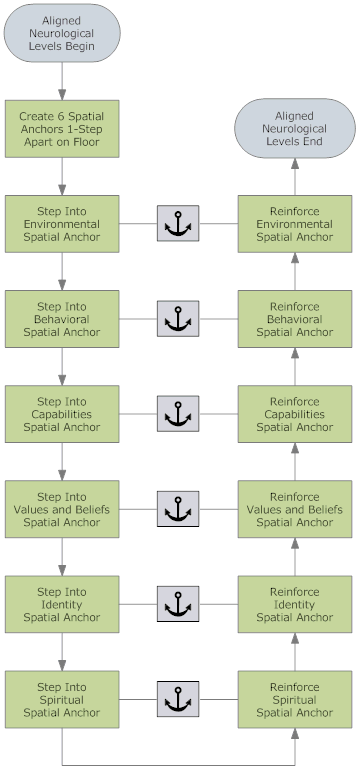The Idea:
Aligning Neurological Levels, or the Aligned Self Pattern is one of my very favorite NLP patterns, because it can be a whole intervention in itself. It is based on the work of Robert Dilts, who discovered that people operate at different levels at different times, and when these levels are out of alignment with each other, people not only feel stuck, they are perceptibly stuck.
Like the Circle of Excellence, this pattern works extremely well both with individuals and in groups. This pattern is good for both remedial and generative work.
The Pattern:

1. Create 6 Spatial Anchors 1-Step Apart on the Floor
Lay down 6 cards or coins about 1 step apart on the floor extending out in front of the explorer.
Each one of the cards will be spatially anchored as follows:
- Environment (i.e. times and places)
- Behaviors (i.e. behaviors, thoughts and states)
- Capabilities (i.e. resources and skills)
- Values and Beliefs (i.e. what's important or necessary)
- Identity (i.e. who and what you are)
- Spirit (i.e. highest intent and purpose, who else is touched)
2. Step Into the Environmental Spatial Anchor
- Think of the times and places where you will want and need to be as congruent and resourceful as possible.
- Think of another time and place where you will want and need these resources.
3. Step Into the Behavioral Spatial Anchor
- Now, take a step forward into the next space, and think of all the behaviors you will need to achieve your outcome... your state, your thoughts and attitude, your posture and breathing, the way you speak and move.
4. Step Into the Capabilities Spatial Anchor
- Now, take a step forward into the next space, and think of all the resources, skills, knowledge, people, information, strengths and abilities you will need to achieve your outcome...
- Make sure these resources are ecologically sound... good.
5. Step Into the Values and Beliefs Spatial Anchor
- Now, take a step forward and imagine the kinds of beliefs and values that serve you in achieving your outcome.
- Take a moment to state those positive beliefs to yourself and notice how they support you in achieving your outcome.
- Take a moment to organize your values so that first things come first... good.
6. Step Into the Identity Spatial Anchor
- Now, take a step forward to notice how well who you are aligns with your pursuit and achievement of your outcome.
- Take a moment to more perfectly align your identity with this pursuit... good... that's it.
7. Step Into the Spiritual Spatial Anchor
- Now, take a final step into the realm of the eternal. Reflect on the positive legacy your contributions have left for mankind and posterity.
- Take a moment to experience how that will look, sound and feel to have done something positive for others, and allow that experience to soak in, now.
8. Reinforce the Spiritual Spatial Anchor
- Now, turn around 180 degrees and face the direction you came.
- Take a moment now to reflect on how this highest purpose and intent can inform, modulate and enlighten all other aspects of your life.
9. Reinforce the Identity Spatial Anchor
- Now take a step forward, and having experienced the eternal perspective, notice now how your identity has been deeply shaped in powerful ways.
- Take a moment to project how this more powerful you will engage in the world.
10. Reinforce the Values and Beliefs Spatial Anchor
- Now take a step forward, and having updated what it means to be you now, notice how your beliefs and values are informed, revised, updated and aligned naturally and easily.
- Notice how easily it is to recognize and place first things first. Now imagine how those important things will easily get done, and how the less important things can also get done in due time.
- Notice how confident you feel that you are also doing the right things.
11. Reinforce the Capabilities Spatial Anchor
- Now take a step forward, and having updated and revised your priorities, values and beliefs, notice how your learning is accelerated, focused on what you'll need when you'll need it.
- Notice also how your confidence and competence have also grown up side-by-side and how they support each other. Notice yourself in a flow state, enjoying being good at what you do now.
12. Reinforce the Behavioral Spatial Anchor
- Now take a step forward, and see yourself as a detached observer, performing with confidence and competence those new skills and capabilities, and notice how your thoughts, emotions, posture, breathing, expression, speech, motions, decisions are all enhanced and perfected.
- And now just step into that experience as yourself and see, hear and feel yourself doing these things as naturally, smoothly and easily as you saw your self when detached... good.
13. Reinforce the Environmental Spatial Anchor
Finally, take a last step forward, and bring all of these new resources, skills, powers into real-projected future places and times. See yourself doing everything fully congruent in these situations, notice what day and time it is, what you are wearing, who is present, and just feel great!
When to Use this Pattern:
Align Neurological Levels as a great group introduction to NLP. This is also an excellent exercise to finish off a chain of NLP interventions, because it reinforces and integrates learnings covering the gamut across all levels of experience.
Do try this exercise, it comes highly recommended. NLP Comprehensive also favors this exercise during their integration week at the end of Practitioner training, and for good reason!
Credits:
Robert Dilts